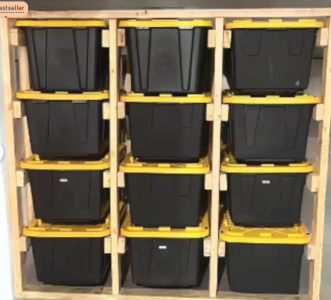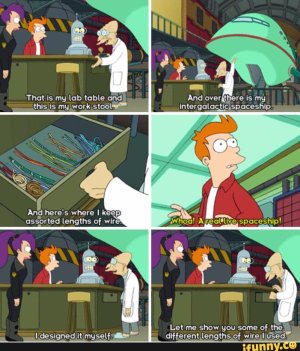Kaido
Elite Member & Kitchen Overlord
- Feb 14, 2004
- 51,579
- 7,247
- 136
A+ for the Simpsons-ifying
I take issue with the image of the little girl making that "yummmm" face. Cherries are not yummy. At least, none that I have ever tasted. And they are usually too expensive for me to give them a try again.It's cherry season here! I picked up this cool cherry pitter:
It has a spring that shoots the pit out like a shotgun lol. Here are 930 cherry recipes:
View attachment 127398
I take issue with the image of the little girl making that "yummmm" face. Cherries are not yummy. At least, none that I have ever tasted. And they are usually too expensive for me to give them a try again.
It's cherry season here! I picked up this cool cherry pitter:
It has a spring that shoots the pit out like a shotgun lol. Here are 930 cherry recipes:
View attachment 127398

I'm a hoarder due to Inattentive ADHD. I solved it like this:
1. Single spreadsheet called MLOE ("Master List Of Everything"). Google Drive, searchable. 5 columns:
Quantity | Part name | Bag number | Bin number | Notes
For example:
6x | HDMI cables | Bag #4 | Bin #2 | Various length HDMI cables
2. Everything that fits goes in a 27-gallon yellow-top tote bin, unless I use it on a regular basis. Everything goes in a Ziploc bag (1, 2.5, or 5 gallon). Every bag gets labeled with painter's tape. Each label has the MLOE #, Bag #, and Bin #. I can find anything I own instantly as a result. Big stuff goes on a shelf with a painter's tape label.
3. They sell storage racks or you can buy plans on Etsy so that you can slide the bins out. I use the "reverse sorting" procedure: dump the whole bin out on a table & then put each bag back in until I find the one I want, then slide the rest of the bags back in the bin. I do a lot of hobbies with tons of parts (cooking, 3D printing, computers, home theater, etc.). This way my workspaces stay clean & usable for instant access & my inventory requires zero rummaging.
Everything I own is on that spreadsheet. I only use labels on the storage bags & bins. If I buy something new on Amazon (ex. cherry pitter), it gets an MLOE #, bag #, and bin #. I add it to the spreadsheet & then I'm done forever! That way next year I can dig it out for the summer & actually FIND IT!!
View attachment 127564
I'm not gonna lie I kind of love this but there is not a snowballs chance in hell I would ever be able to convince my wife to even try this. Her idea of kitchen organization is shove it in any drawer that fits.I'm a hoarder due to Inattentive ADHD. I solved it like this:
1. Single spreadsheet called MLOE ("Master List Of Everything"). Google Drive, searchable. 5 columns:
Quantity | Part name | Bag number | Bin number | Notes
For example:
6x | HDMI cables | Bag #4 | Bin #2 | Various length HDMI cables
2. Everything that fits goes in a 27-gallon yellow-top tote bin, unless I use it on a regular basis. Everything goes in a Ziploc bag (1, 2.5, or 5 gallon). Every bag gets labeled with painter's tape. Each label has the MLOE #, Bag #, and Bin #. I can find anything I own instantly as a result. Big stuff goes on a shelf with a painter's tape label.
3. They sell storage racks or you can buy plans on Etsy so that you can slide the bins out. I use the "reverse sorting" procedure: dump the whole bin out on a table & then put each bag back in until I find the one I want, then slide the rest of the bags back in the bin. I do a lot of hobbies with tons of parts (cooking, 3D printing, computers, home theater, etc.). This way my workspaces stay clean & usable for instant access & my inventory requires zero rummaging.
Everything I own is on that spreadsheet. I only use labels on the storage bags & bins. If I buy something new on Amazon (ex. cherry pitter), it gets an MLOE #, bag #, and bin #. I add it to the spreadsheet & then I'm done forever! That way next year I can dig it out for the summer & actually FIND IT!!
View attachment 127564
I'm a hoarder due to Inattentive ADHD. I solved it like this:
1. Single spreadsheet called MLOE ("Master List Of Everything"). Google Drive, searchable. 5 columns:
Quantity | Part name | Bag number | Bin number | Notes
For example:
6x | HDMI cables | Bag #4 | Bin #2 | Various length HDMI cables
2. Everything that fits goes in a 27-gallon yellow-top tote bin, unless I use it on a regular basis. Everything goes in a Ziploc bag (1, 2.5, or 5 gallon). Every bag gets labeled with painter's tape. Each label has the MLOE #, Bag #, and Bin #. I can find anything I own instantly as a result. Big stuff goes on a shelf with a painter's tape label.
3. They sell storage racks or you can buy plans on Etsy so that you can slide the bins out. I use the "reverse sorting" procedure: dump the whole bin out on a table & then put each bag back in until I find the one I want, then slide the rest of the bags back in the bin. I do a lot of hobbies with tons of parts (cooking, 3D printing, computers, home theater, etc.). This way my workspaces stay clean & usable for instant access & my inventory requires zero rummaging.
Everything I own is on that spreadsheet. I only use labels on the storage bags & bins. If I buy something new on Amazon (ex. cherry pitter), it gets an MLOE #, bag #, and bin #. I add it to the spreadsheet & then I'm done forever! That way next year I can dig it out for the summer & actually FIND IT!!
View attachment 127564



